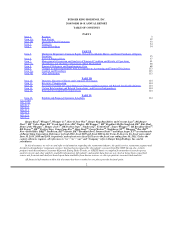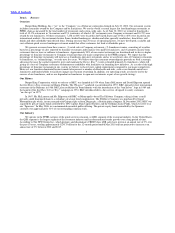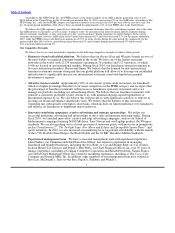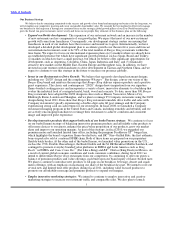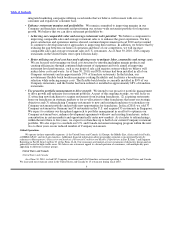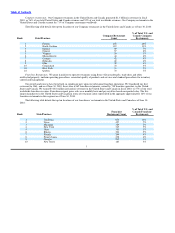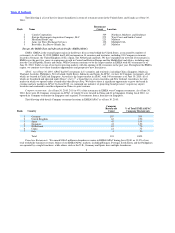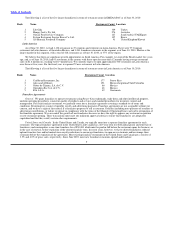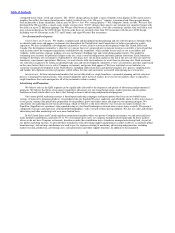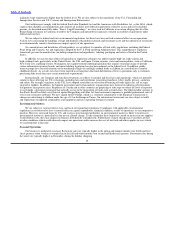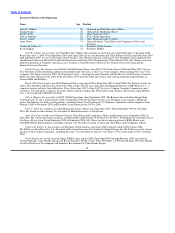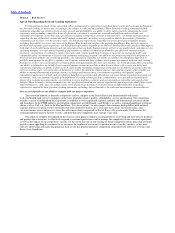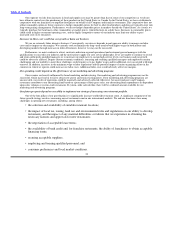Burger King 2010 Annual Report Download - page 14
Download and view the complete annual report
Please find page 14 of the 2010 Burger King annual report below. You can navigate through the pages in the report by either clicking on the pages listed below, or by using the keyword search tool below to find specific information within the annual report.
Table of Contents
corrugated metal, brick, wood and concrete. The “20/20” design options include a series of liquid crystal display (LCD) menu screens,
graphics that reflect the famous brand promise, highly visible Home of the Whopper® signage, a prominent red flame parapet dining
area anchored by a flame chandelier, and an array of Have it Your Way seating options — bar, banquette, booth, or table. We have also
developed the Whopper Bar, a small−scale, trendy version of our “20/20” design where guests can customize our signature burger with
the choice of up to 22 different toppings. The Whopper Bar boasts an open kitchen, a bar−like countertop, and the same red, black, and
gray restaurant design as the 20/20 design. System−wide there are currently more than 300 restaurants with the new 20/20 design,
including over 40 restaurants in the U.S. and Canada, and eight Whopper Bar restaurants.
New Restaurant Development
United States and Canada. We employ a sophisticated and disciplined market planning and site selection process through which
we identify trade areas and approve restaurant sites throughout the United States and Canada that we believe provides for quality
expansion. We have established a development committee to oversee all new restaurant development within the United States and
Canada. Our development committee’s objective is to ensure that every proposed new restaurant location is carefully reviewed and that
each location meets the stringent requirements established by the committee, which include factors such as site accessibility and
visibility, traffic patterns, signage, parking, site size in relation to building type and certain demographic factors. Our model for
evaluating sites accounts for potential changes to the site, such as road reconfiguration and traffic pattern alterations. Each franchisee
wishing to develop a new restaurant is responsible for selecting a new site location and bears the risk if the new site does not meet the
franchisee’s investment expectations. However, we work closely with our franchisees to assist them in selecting sites. Each restaurant
site selected is required to be within an identified trade area and our development committee reviews all selections, provides input based
on the same factors that it uses to select Company restaurants, and grants final approval. We have instituted several initiatives to
accelerate restaurant development in the United States, including reduced royalties and upfront franchise fees, process simplifications
and turnkey development assistance programs, which reduce the time and uncertainty associated with opening new restaurants.
International. In those international markets that are not allocated to a single franchisee, our market planning and site selection
process is managed by regional teams, who are knowledgeable about the local market. In several of our markets, there is typically a
single franchisee that owns and operates all of the restaurants within a country.
Advertising and Promotion
We believe sales in the QSR segment can be significantly affected by the frequency and quality of advertising and promotional
programs. We believe that three of our major competitive advantages are our strong brand equity, market position and our global
franchise network which allow us to drive sales through extensive advertising and promotional programs.
Our current global marketing strategy is based upon marketing campaigns and menu options that focus on our barbell menu
strategy of innovative premium products, core products like our flagship Whopper sandwich, and affordable items to offer more choices
to our guests, enhance the price/value proposition of our products, grow our market share and improve our operating margins. We
concentrate our marketing on television advertising, which we believe is the most effective way to reach our target customer, the
SuperFan. SuperFans are consumers who reported eating at a fast food hamburger restaurant nine or more times a month. The group is
comprised of all ages and represents all household demographics, with over half of them having children. We also use radio and internet
advertising and other marketing tools on a more limited basis.
In the United States and Canada and those international markets where we operate Company restaurants, we and our franchisees
make monthly contributions, generally 4% to 5% of restaurant gross sales, to Company managed advertising funds. In those markets
where we do not have Company restaurants, franchisees make this contribution into a franchisee managed advertising fund. As part of
our global marketing strategy, we provide these franchisees with advertising support and guidance in order to deliver a consistent global
brand message. Advertising contributions are used to pay for expenses relating to marketing, advertising and promotion, including
market research, production, advertising costs, sales promotions and other support functions. In addition to the mandated
12


